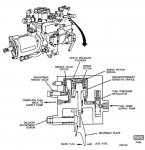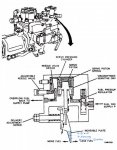rustystud
Well-known member
- 9,402
- 3,392
- 113
- Location
- Woodinville, Washington
I see people where still posting wrong information here after I left.
So again I will try and show you how the plate in the FDC still moves all the time.
As you can see from the diagram the wedge plate is connected to the piston which moves according to the pressure exerted against it. This pressure is variable due to the viscosity of the fuel being used and the main fuel line pressure. It's just a matter of how much it moves. The pressure on the regulating valve is not static but will give you a difference value of around 20 PSI . This pressure will change due to the main fuel pressure (anyone with any common sense can see that) but it will maintain this 20 PSI difference due to the spring pressure exerted against it. For anyone who still believes this regulating value just maintains 20 PSI, then explain to me why even have a FDC ? If your pressure is a constant that never changes what is it's purpose then ?
There are two constants in the FDC. The "orifice" in the top of the Servo and the "Servo Spring". In combination with the differentiating regulator valve and the "viscosity" of the fuel used you get movement to the plate which in turns pushes on the governor. There is a "needle valve" after the servo piston but it's purpose is to adjust or "Trim" the servo according to set spec's according to the fuels used. Mainly Diesel and Gasoline and Kerosene . Do not play with this needle valve. You need complicated equipment to set it correctly.
So again I will try and show you how the plate in the FDC still moves all the time.
As you can see from the diagram the wedge plate is connected to the piston which moves according to the pressure exerted against it. This pressure is variable due to the viscosity of the fuel being used and the main fuel line pressure. It's just a matter of how much it moves. The pressure on the regulating valve is not static but will give you a difference value of around 20 PSI . This pressure will change due to the main fuel pressure (anyone with any common sense can see that) but it will maintain this 20 PSI difference due to the spring pressure exerted against it. For anyone who still believes this regulating value just maintains 20 PSI, then explain to me why even have a FDC ? If your pressure is a constant that never changes what is it's purpose then ?
There are two constants in the FDC. The "orifice" in the top of the Servo and the "Servo Spring". In combination with the differentiating regulator valve and the "viscosity" of the fuel used you get movement to the plate which in turns pushes on the governor. There is a "needle valve" after the servo piston but it's purpose is to adjust or "Trim" the servo according to set spec's according to the fuels used. Mainly Diesel and Gasoline and Kerosene . Do not play with this needle valve. You need complicated equipment to set it correctly.
Attachments
-
47.5 KB Views: 25
Last edited:





